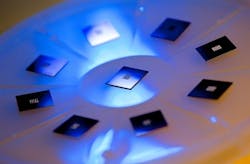Automated laser cutting pays off
David A. Belforte
A Belgium plant uses a laser system with a recent automation upgrade to cut costs
In 1975, Herman De Mil and partner Karel De Regge combined their experience to start a company, Garmat Spraybooth, which is today the top supplier of spraybooths to the global coachwork market. Products turned out from the 10,000 m2 plant in Erpe-Mere, Belgium, and an 11,000 m2 plant in Englewood, Colorado, are standard and custom metal spraybooths for industrial markets such as truck and car assembly and other industrial market sectors that paint and spray components. A typical spray booth installed for a European auto maker is seen in FIGURE 1.
Recently Herman and his son Ben walked me and several colleagues through the plant in Belgium, where we have come to see the company’s newest automated metal processing system, an LVD Strippit Axel CO2 laser cutting system. Actually, Garmat installed the Axel 4020S (shown in FIGURE 2) in 2008, but the De Mils, recognizing the need to increase capacity without adding another laser system, upgraded the laser cutter last year with the addition of an automated load/unload system.
That sounds a little simpler than the actual installation process. Because of tight floor space limitations, the load/unload system had to be located in an adjacent factory unit. The separating wall was opened up (as shown in FIGURE 3) so that the load/unload system could move from the shuttle table into the unload area. There, the fork unloading device unloads processed sheets, and a gantry-mounted air suction device then picks up the next sheet to be processed from one of three other pallets. The pickup head is shown in FIGURE 4.
Garmat uses galvanized and galvanneal steel in the fabrication of the paint booths and some stainless steel for smaller paint boxes. Most of the booths use sheet thickness to 16 gauge, and since all parts are eventually painted for assembly, the edges have to be perfect with no burrs or oxidized layers that could affect paint adherence. Thus, the company performs all this laser cutting using nitrogen as the assist gas. Cutting in the endothermic mode (byproducts vaporized) leaves an oxide-free edge. Prior to laser cutting, these parts were stamped and/or punched, and any remaining edge burrs had to be ground off. The improved laser-cut edges are superior, and there is no labor needed for burr removal.
An unexpected benefit of laser cutting, according to Ben De Mil, is the cut to exact size of the laser process, which means the panels can now be designed to be joined by riveting rather than welding. Rivet holes are now produced to exact dimensions, repeatedly sheet to sheet. As a consequence, Garmat reduces the number of welders used in the process from 10 to three and the latter are employed on special assembly jobs. The displaced welders were retrained and are now performing other tasks in the production operation.
Garmat produces to order only, and therefore production control is an important factor in managing fluctuating manufacturing costs. Ben De Mil recognizes the need for an ERP system and is now investigating it, but he adds that the automated laser cutting system makes the analysis of cost controls relatively easy.
The company still uses mechanical stamping equipment, so they always have that process as a fall-back if the orders increase beyond the laser capability. That said, Ben De Mil suggests another laser cutter may be considered in the near future.
FIGURE 4. The automated pick-up and movement system.
Garmat now manufactures about 10-12 booths per week in the Belgium plant and considerably more in the Denver plant, where they do not laser cut at this time. The U.S. plant now handles all North and South American orders, which reduced the Belgium export business by about half. They now run on a single production shift with extra laser cutting providing another half shift, running unattended. Interestingly the extra shift is used for short-run orders.
While we were visiting, the day shift ended and most of the employees exited, turning out the lights as they left, All that was still running was the laser cutter, unattended, being fed by the automatic load/unload feature.
The last stop on the plant tour was the paint shop, where three Garmat spray booths, one automated for white powder coating, one for colored powder coating, and one for wet paint are used to coat all parts.
The De Mils are completely satisfied with the laser system and the recent automation addition. When asked about downtime and service, they smiled and said, “No need yet,” a ringing endorsement for the installation.


